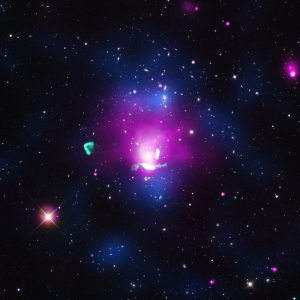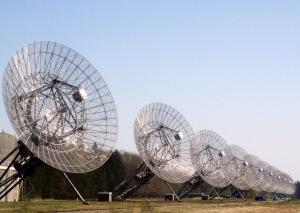Produced by shockwaves compressing and re-energizing dormant clouds of electrons that shine at radio frequencies

High-energy X-rays detected by NASA’s Chandra X-ray Observatory are seen in pink in the image above, while radio data from NSF’s Karl Jansky Very Large Array (VLA) is green. A map of the density of galaxies in the region, seen in blue was obtained by analysis of optical data.
Space news (September 14, 2015) – 1.6 billion light-years from Earth in Abell 1033 –
Astronomers and astrophysicists looking at data provided by NASA’s Chandra X-ray Observatory, the Sloan Digital Sky Survey (SDSS), NSF’s Karl Jansky Very Large Array (VLA) and the Westerbork Synthesis Radio Telescope have detected what they refer to as a “Radio Phoenix“.

A Radio Phoenix as seen in the multiwavelength photo at the top of the page is a cloud of bright radio emission of high-energy electrons thousands of light-years across that originally erupted from the supermassive black hole near the center of Abell 1033. As the cloud expanded it faded over time as electrons within lost energy, until millions of years later it was reborn when shockwaves from a collision between Abell 1033 and another galaxy cluster compressed and re-energized the electrons, causing the cloud to shine as a Radio Phoenix.
This Radio Phoenix is expected to be reborn for only a few tens of million of years, just a blink of an eye on cosmic scales. The intense density and pressures in the region and powerful magnetic fields near the center of Abell 1033 will cause it to eventually fade into darkness.
To learn more about the Chandra X-ray Observatory go here.
Discover NSF’s Karl Jansky Very Large Array (VLA) here.
Learn more about the Westerbork Synthesis Radio Telescope here.
Learn more about NASA’s space mission here.
Go here to discover more about the Sloan Digital Sky Survey.
Learn more about Pluto and a recent visit by NASA’s New Horizons spacecraft.
Discover the search for the missing link in black hole evolution.
